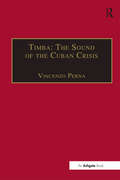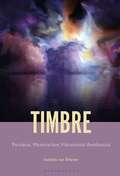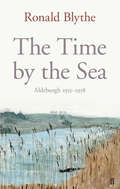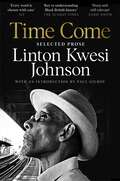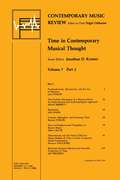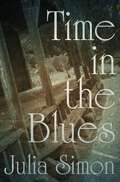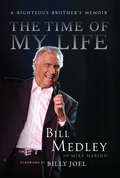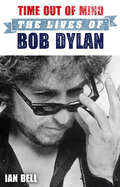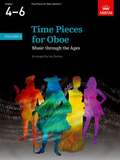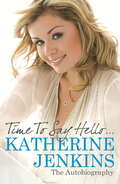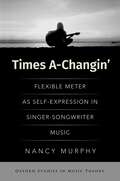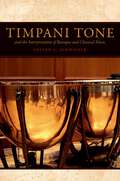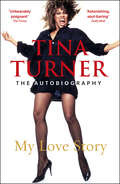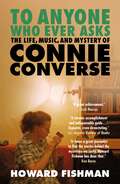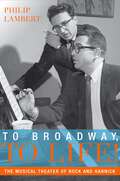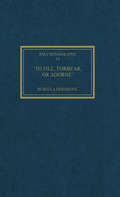- Table View
- List View
Timba: The Sound of the Cuban Crisis
by Vincenzo PernaCuban music is recognized unanimously as a major historical force behind Latin American popular music, and as an important player in the development of US popular music and jazz. However, the music produced on the island after the Revolution in 1959 has been largely overlooked and overshadowed by the Buena Vista Social Club phenomenon. The Revolution created the conditions for the birth of a type of highly sophisticated popular music, which has grown relatively free from market pressures. These conditions premised the new importance attained by Afro-Cuban dance music during the 1990s, when the island entered a period of deep economic and social crisis that has shaken Revolutionary institutions from their foundations. Vincenzo Perna investigates the role of black popular music in post-Revolutionary Cuba, and in the 1990s in particular. The emergence of timba is analysed as a distinctively new style of Afro-Cuban dance music. The controversial role of Afro-Cuban working class culture is highlighted, showing how this has resisted co-optation into a unified, pacified vision of national culture, and built musical bridges with the transnational black diaspora. Musically, timba represents an innovative fusion of previous popular and folkloric Afro-Cuban styles with elements of hip-hop and other African-American styles like jazz, funk and salsa. Timba articulates a black urban youth subculture with distinctive visual and choreographic codes. With its abrasive commentaries on issues such as race, consumer culture, tourism, prostitution and its connections to the underworld, timba demonstrates at the 'street level' many of the contradictions of contemporary Cuban society. After repeatedly colliding with official discourses, timba has eventually met with institutional repression. This book will appeal not only to ethnomusicologists and those working on popular music studies, but also to those working in the areas of cultural and Black studies, anthropology, Latin American st
Timba: The Sound of the Cuban Crisis
by Vincenzo PernaCuban music is recognized unanimously as a major historical force behind Latin American popular music, and as an important player in the development of US popular music and jazz. However, the music produced on the island after the Revolution in 1959 has been largely overlooked and overshadowed by the Buena Vista Social Club phenomenon. The Revolution created the conditions for the birth of a type of highly sophisticated popular music, which has grown relatively free from market pressures. These conditions premised the new importance attained by Afro-Cuban dance music during the 1990s, when the island entered a period of deep economic and social crisis that has shaken Revolutionary institutions from their foundations. Vincenzo Perna investigates the role of black popular music in post-Revolutionary Cuba, and in the 1990s in particular. The emergence of timba is analysed as a distinctively new style of Afro-Cuban dance music. The controversial role of Afro-Cuban working class culture is highlighted, showing how this has resisted co-optation into a unified, pacified vision of national culture, and built musical bridges with the transnational black diaspora. Musically, timba represents an innovative fusion of previous popular and folkloric Afro-Cuban styles with elements of hip-hop and other African-American styles like jazz, funk and salsa. Timba articulates a black urban youth subculture with distinctive visual and choreographic codes. With its abrasive commentaries on issues such as race, consumer culture, tourism, prostitution and its connections to the underworld, timba demonstrates at the 'street level' many of the contradictions of contemporary Cuban society. After repeatedly colliding with official discourses, timba has eventually met with institutional repression. This book will appeal not only to ethnomusicologists and those working on popular music studies, but also to those working in the areas of cultural and Black studies, anthropology, Latin American st
Timbre: Paradox, Materialism, Vibrational Aesthetics
by Isabella Van ElferenTimbre is among the most important and the most elusive aspects of music. Visceral and immediate in its sonic properties, yet also considered sublime and ineffable, timbre finds itself caught up in metaphors: tone “color”, “wet” acoustics, or in Schoenberg's words, “the illusory stuff of our dreams.” This multi-disciplinary approach to timbre assesses the acoustic, corporeal, performative, and aesthetic dimensions of tone color in Western music practice and philosophy. It develops a new theorization of timbre and its crucial role in the epistemology of musical materialism through a vital materialist aesthetics in which conventional binaries and dualisms are superseded by a vibrant continuum. As the aesthetic and epistemological questions foregrounded by timbre are not restricted to isolated periods in music history or individual genres, but have pervaded Western musical aesthetics since early Modernity, the book discusses musical examples taken from both “classical” and “popular” music. These range, in “classical” music, from the Middle Ages through the Baroque, the belcanto opera and electronic music to saturated music; and, in “popular” music, from indie through soul and ballad to dark industrial.
Timbre: Paradox, Materialism, Vibrational Aesthetics
by Isabella Van ElferenTimbre is among the most important and the most elusive aspects of music. Visceral and immediate in its sonic properties, yet also considered sublime and ineffable, timbre finds itself caught up in metaphors: tone “color”, “wet” acoustics, or in Schoenberg's words, “the illusory stuff of our dreams.” This multi-disciplinary approach to timbre assesses the acoustic, corporeal, performative, and aesthetic dimensions of tone color in Western music practice and philosophy. It develops a new theorization of timbre and its crucial role in the epistemology of musical materialism through a vital materialist aesthetics in which conventional binaries and dualisms are superseded by a vibrant continuum. As the aesthetic and epistemological questions foregrounded by timbre are not restricted to isolated periods in music history or individual genres, but have pervaded Western musical aesthetics since early Modernity, the book discusses musical examples taken from both “classical” and “popular” music. These range, in “classical” music, from the Middle Ages through the Baroque, the belcanto opera and electronic music to saturated music; and, in “popular” music, from indie through soul and ballad to dark industrial.
The Time by the Sea: Aldeburgh 1955-1958
by Dr Dr Ronald BlytheThe Time by the Sea is about Ronald Blythe's life in Aldeburgh during the 1950s. He had originally come to the Suffolk coast as an aspiring young writer, but found himself drawn into Benjamin Britten's circle and began working for the Aldeburgh Festival. Although befriended by Imogen Holst and by E M Forster, part of him remained essentially solitary, alone in the landscape while surrounded by a stormy cultural sea. But this memoir gathers up many early experiences, sights and sounds: with Britten he explored ancient churches; with the botanist Denis Garrett he took delight in the marvellous shingle beaches and marshland plants; he worked alongside the celebrated photo-journalist Kurt Hutton. His muse was Christine Nash, wife of the artist John Nash. Published to coincide with the centenary of Britten's birth, this is a tale of music and painting, unforgettable words and fears. It describes the first steps of an East Anglian journey, an intimate appraisal of a vivid and memorable time.
Time Come: Selected Prose
by Linton Kwesi Johnson‘Key to understanding Black British history’ – The Sunday Times‘Sharp and still relevant’ – Zadie SmithOne of the great poets of modern times, and a deeply respected political and cultural activist and social critic, Linton Kwesi Johnson is also a prolific writer of non-fiction. In Time Come, he selects some of his most powerful prose – book and music reviews published in newspapers and magazines, lectures, obituaries and speeches – for the first time. Written over many decades, these works draw on Johnson’s own Jamaican roots and on Caribbean history to explore the politics of race that continue to inform the Black British experience.Ranging from reflections on the place of music in Caribbean and Black British culture as a creative, defiant response to oppression, to penetrating appraisals of novels, films, poems and plays, and including warm tributes paid to the activists and artists who inspired him to contribute to the struggle for racial equality and social justice, Time Come is a panorama of an exceptional life. Venturing into memoir, it underscores Johnson’s enduring importance in Britain’s cultural history and reminds us of his brilliant, unparalleled legacy.With an introduction by Paul Gilroy, author of There Ain’t No Black in the Union Jack.‘A mosaic of wise, urgent and moving pieces’ – Kit de Waal‘As necessary as ever’ – The Observer‘A book to be savoured and re-read’ – Derek Owusu‘An outstanding collection’ – Caryl Phillips‘A necessary book from a writer who continues to inspire’ – Yomi Sode‘Incisive, engaging, fearless’ – Gary Younge
Time in Contemporary Musical Thought (Contemporary Music Review)
by Jonathan D. KramerFirst Published in 1993. Routledge is an imprint of Taylor & Francis, an informa company.
Time in Contemporary Musical Thought (Contemporary Music Review #Vols. 7, Pts. 2)
by Jonathan D. KramerFirst Published in 1993. Routledge is an imprint of Taylor & Francis, an informa company.
Time in the Blues
by Julia SimonSpontaneity, immediacy and feeling characterize the blues as a genre. Whether it's the movement of call and response, the expressive bends and wails of voice and instruments or the synergistic relationship between audience and performers, the blues embody a kind of "living in the moment" aesthetic. At the same time, the blues genre has always responded in a unique way to its historical moment, its formal characteristics, figures, and devices constantly emerging from--and speaking to--the social relations emanating from Jim Crow segregation, sharecropping, racist violence, and migration. Time in the Blues presents an interdisciplinary analysis of the specific forms of temporality produced by and reflected in the blues. Examining time as it is represented, enacted, and experienced through the blues, interdisciplinary scholar Julia Simon addresses how the material conditions in the early twentieth century shaped a musical genre. The technical aspects of the blues--ostinato patterns, cyclical changes, improvisation, call and response--emerge from and speak to the Jim Crow era's economic, social, and political relations. Through this temporal analysis, Simon addresses how the moment-to-moment aspect of time in blues performance relates to the genre's location within historical time, with careful examinations of the historical performance and reception of blues music from the 1920s to the present day. Simon examines the structuring of time, and analyzes temporality to open the broader questions of desire, agency, self-definition, faith, and forms of resistance as they are articulated in this music. Ultimately, Time in the Blues, argues for the relevance, significance, and importance of time in the blues for shared values of community and a vision of social justice.
Time in the Blues
by Julia SimonSpontaneity, immediacy and feeling characterize the blues as a genre. Whether it's the movement of call and response, the expressive bends and wails of voice and instruments or the synergistic relationship between audience and performers, the blues embody a kind of "living in the moment" aesthetic. At the same time, the blues genre has always responded in a unique way to its historical moment, its formal characteristics, figures, and devices constantly emerging from--and speaking to--the social relations emanating from Jim Crow segregation, sharecropping, racist violence, and migration. Time in the Blues presents an interdisciplinary analysis of the specific forms of temporality produced by and reflected in the blues. Examining time as it is represented, enacted, and experienced through the blues, interdisciplinary scholar Julia Simon addresses how the material conditions in the early twentieth century shaped a musical genre. The technical aspects of the blues--ostinato patterns, cyclical changes, improvisation, call and response--emerge from and speak to the Jim Crow era's economic, social, and political relations. Through this temporal analysis, Simon addresses how the moment-to-moment aspect of time in blues performance relates to the genre's location within historical time, with careful examinations of the historical performance and reception of blues music from the 1920s to the present day. Simon examines the structuring of time, and analyzes temporality to open the broader questions of desire, agency, self-definition, faith, and forms of resistance as they are articulated in this music. Ultimately, Time in the Blues, argues for the relevance, significance, and importance of time in the blues for shared values of community and a vision of social justice.
The Time of My Life: A Righteous Brother's Memoir
by Bill MedleyFrom an early age, Bill Medley had a passion for music. School glee club and amateur singing contests soon gave way to the albums of Ray Charles and Little Richard. That raw R&B influence would profoundly shape Medley's musical future.As the pioneering "blue-eyed soul” group the Righteous Brothers, Bill Medley and late partner Bobby Hatfield sang such huge hits as "(You're My) Soul and Inspiration,” "Unchained Melody,” and "You've Lost That Lovin' Feelin',” the latter recognized by BMI as the most-played song of the twentieth century. Medley's duet with Jennifer Warnes for the Dirty Dancing soundtrack, "(I've Had) the Time of My Life,” became a worldwide No. 1 single on its way to winning an Oscar, a Grammy, and a Golden Globe.But Medley's story isn't just about the hits and the awards. It's about an immensely talented man who reached the pinnacle of fame, success, and excess, until the shocking murder of his wife, Karen. In time, this tragedy eventually helped him renew his commitment to both faith and family.
The Time of My Life: A Righteous Brother's Memoir
by Bill MedleyFrom an early age, Bill Medley had a passion for music. School glee club and amateur singing contests soon gave way to the albums of Ray Charles and Little Richard. That raw R&B influence would profoundly shape Medley's musical future.As the pioneering "blue-eyed soul” group the Righteous Brothers, Bill Medley and late partner Bobby Hatfield sang such huge hits as "(You're My) Soul and Inspiration,” "Unchained Melody,” and "You've Lost That Lovin' Feelin',” the latter recognized by BMI as the most-played song of the twentieth century. Medley's duet with Jennifer Warnes for the Dirty Dancing soundtrack, "(I've Had) the Time of My Life,” became a worldwide No. 1 single on its way to winning an Oscar, a Grammy, and a Golden Globe.But Medley's story isn't just about the hits and the awards. It's about an immensely talented man who reached the pinnacle of fame, success, and excess, until the shocking murder of his wife, Karen. In time, this tragedy eventually helped him renew his commitment to both faith and family.
Time Out of Mind: The Lives of Bob Dylan
by Ian BellBy the middle of the 1970s, Bob Dylan’s position as the pre-eminent artist of his generation was assured. The 1975 album Blood on the Tracks seemed to prove, finally, that an uncertain age had found its poet.Perverse or driven, Dylan refused the role. By the decade’s end, the counter-culture’s poster child had embraced conservative, evangelical Christianity. Fans and critics alike were confused; many were aghast. Still the hits kept coming.Then Dylan faltered. His instincts, formerly unerring, deserted him. In the 1980s, what had once appeared unthinkable came to pass: the ‘voice of a generation’ began to sound irrelevant, a tale told to grandchildren.Yet in the autumn of 1997 something remarkable happened. Having failed to release a single new song in seven long years, Dylan put out the equivalent of two albums in a single package. He called it Time Out of Mind. So began the renaissance, artistic and personal, that culminated in 2012’s acclaimed Tempest.In the concluding volume of his groundbreaking study, Ian Bell explores the unparalleled second act in a quintessentially American career. It is a tale of redemption, of an act of creative will against the odds, and of a writer who refused to fade away.Time Out of Mind is the story of the latest, perhaps the last, of the many Bob Dylans. This one might yet turn out to have been the most important of them all.
Time Pieces for Oboe, Volume 2: Music through the Ages (Time Pieces)
by AbrsmThe second of a two-volume anthology presenting attractive repertoire for oboe and piano from the sixteenth century to the present day. Each volume presents the pieces in chronological order and prints the year in which they were written, giving a feel of different styles of music through time.
Time to Say Hello: My Autobiography
by Katherine JenkinsThe UK's biggest-selling classical artist reveals how her angelic voice has shot her to superstardom...Katherine Jenkins is an international singing superstar who has redefined a music genre: she has brought classical music to the masses and inspired young and old with her incredible voice, her glamorous looks and, above all, her love for music, her country and her fans.Born in Neath, South Wales, Katherine won national acclaim as the BBC Welsh Choirgirl of the year and soon after a place at the Royal Academy of Music. Auditioning for a terrifying panel of industry experts at Universal Music she came away with the largest recording deal in classical music history. And so began Katherine's meteoric rise to stardom.TIME TO SAY HELLO is Katherine's incredible story. Packed with laughter, adventure, heartbreak and music, it is the tale of a dream coming true and one that will keep you gripped to the last note ¿
Times A-Changin': Flexible Meter as Self-Expression in Singer-Songwriter Music (OXFORD STUDIES IN MUSIC THEORY)
by Nancy MurphyIn 1960s and 1970s singer-songwriter music, some artists used malleable metric settings alongside other features of self-expression in performance. This resulted in songs with extremes of self-expressive timing flexibility that cannot be accounted for using a single conception of meter. This book proposes a theory of flexible meter that recasts metric structure as encompassing the variety of metric scenarios presented by the self-expressive performance practice of singer-songwriters, from metric regularity to metric ambiguity, and vacillations between these two possibilities. Author Nancy Murphy explores performances by Joni Mitchell, Bob Dylan, Buffy Sainte-Marie, Paul Simon, and Cat Stevens to investigate the individual metric style of each artist and how their flexible metric techniques contribute to the self-expressive rhetoric of the singer-songwriter performance tradition.
Times A-Changin': Flexible Meter as Self-Expression in Singer-Songwriter Music (OXFORD STUDIES IN MUSIC THEORY)
by Nancy MurphyIn 1960s and 1970s singer-songwriter music, some artists used malleable metric settings alongside other features of self-expression in performance. This resulted in songs with extremes of self-expressive timing flexibility that cannot be accounted for using a single conception of meter. This book proposes a theory of flexible meter that recasts metric structure as encompassing the variety of metric scenarios presented by the self-expressive performance practice of singer-songwriters, from metric regularity to metric ambiguity, and vacillations between these two possibilities. Author Nancy Murphy explores performances by Joni Mitchell, Bob Dylan, Buffy Sainte-Marie, Paul Simon, and Cat Stevens to investigate the individual metric style of each artist and how their flexible metric techniques contribute to the self-expressive rhetoric of the singer-songwriter performance tradition.
Timpani Tone and the Interpretation of Baroque and Classical Music
by Steven L. SchweizerTimpani Tone and the Interpretation of Baroque and Classical Music explores the nature, production, and evolution of timpani tone and provides insights into how to interpret the music of J. S. Bach, Handel, Haydn, and Mozart. In drawing on 31 years of experience, Steven L. Schweizer focuses on the components of timpani tone and methods for producing it. In so doing, he discusses the importance of timpani bowl type; mallets; playing style; physical gestures; choice of drums; mallet grip; legato, marcato, and staccato strokes; playing different parts of the timpano head; and psychological openness to the music in effectively shaping and coloring timpani parts. In an acclaimed chapter on interpretation, Schweizer explores how timpanists can use knowledge of the composer's style, psychology, and musical intentions; phrasing and articulation; the musical score; and a conductor's gestures to effectively and convincingly play a part with emotional dynamism and power. The greater part of the book is devoted to the interpretation of Baroque and Classical orchestral and choral music. Meticulously drawing on original sources and authoritative scores from the seventeenth through nineteenth centuries, Schweizer convincingly demonstrates that timpanists were capable of producing a broader range of timpani tone earlier than is normally supposed. The increase in timpani size, covered timpani mallets, and thinner timpani heads increased the quality of timpani tone; therefore, today's timpanist's need not be entirely concerned with playing with very articulate sticks. In exhaustive sections on Bach, Handel, Haydn, and Mozart, Schweizer takes the reader on an odyssey through the interpretation of their symphonic and choral music. Relying on Baroque and Classical performance practices, timpani notation, the composer's musical style, and definitive scores, he interprets timpani parts from major works of these composers. Schweizer pays particular attention to timpani tone, articulation, phrasing, and dynamic contouring: elements necessary to effectively communicate their part to listeners.
Tina Turner (Official Autobiography): A Memoir
by Tina Turner_______________________‘Astonishing, soul-baring – the must-read memoir by rock’s greatest survivor’ DAILY MAIL'Unbearably poignant' THE TIMES, Book of the Week*** The full, dramatic story of one of the most remarkable women in music history, celebrating Tina Turner’s 60th year in the industry ***_______________________Love’s got everything to do with it.Tina Turner is the Queen of Rock ‘n’ Roll, a musical icon celebrating her 60th year in the industry. In this dramatic autobiography, she tells the story of a truly remarkable life in the spotlight.From her early years picking cotton in Nutbush, Tennessee to her rise to fame alongside Ike Turner, and finally to her phenomenal success in the 1980s and beyond, Tina candidly examines her personal history, from her darkest hours to her happiest moments and everything in between.In her honest and heart-felt voice, Tina reveals:· How (love) and a kidney transplant saved her life – and how her new husband made an incredible personal sacrifice· How she has coped with the tragic suicide of her son· How ex-husband Ike Turner forced her to go to a brothel on their wedding night… and why she tried to kill herself because of Ike’s mistresses · The Cinderella moment when David Bowie made Tina a star …· …and the day Mick Jagger ripped her skirt off!AND MUCH MOREBrimming with her trademark blend of strength, energy, heart and soul, My Love Story is a gripping, surprising memoir, as memorable and entertaining as any of her greatest hits.
To Anyone Who Ever Asks: The Life, Music, and Mystery of Connie Converse
by Howard FishmanThe mysterious true story of Connie Converse - a mid-century New York singer and songwriter whose haunting music never gained widespread recognition - and one writer's quest to understand her life.When musician and New Yorker contributor Howard Fishman first heard a Connie Converse recording, he was convinced she could not be real. Her music was too out of place for the 1950s to make sense - a singer who bridged the gap between traditional Americana, pop standards, and the singer-songwriter movement that exploded a decade later with Bob Dylan and Joni Mitchell.Fishman was determined to know more about this artist and how she slipped through the cracks of music history but there was one problem: in 1974, at the age of fifty, Converse simply drove off one day and was never heard from again.After a dozen years of research, Fishman expertly weaves a narrative of her life and music, and of how it has come to speak to him as both an artist and a person.It is by turns a hopeful, inspiring, melancholy, and chilling story of dark family secrets, taciturn New England traditions, a portrait of 1950s Greenwich Village, of a visionary intellect and talent, and a woman who fiercely strove for independence when the odds were against her. Ultimately, Fishman places Converse in the canon as a vital, overlooked trailblazer, a missing link pre-empting the reflective, complex, arresting music that transformed the 1960s and music forever.
To Broadway, To Life!: The Musical Theater of Bock and Harnick (Broadway Legacies)
by Philip LambertTo Broadway, To Life! The Musical Theater of Bock and Harnick is the first complete book about these creative figures, one of Broadway's most important songwriting teams. The book draws from personal interviews with Bock and Harnick themselves to offer an in-depth exploration their shows, including Fiddler on the Roof, She Loves Me, and Fiorello!, and their greater place in musical theater history.
To Broadway, To Life!: The Musical Theater of Bock and Harnick (Broadway Legacies)
by Philip LambertTo Broadway, To Life! The Musical Theater of Bock and Harnick is the first complete book about these creative figures, one of Broadway's most important songwriting teams. The book draws from personal interviews with Bock and Harnick themselves to offer an in-depth exploration their shows, including Fiddler on the Roof, She Loves Me, and Fiorello!, and their greater place in musical theater history.
'To fill, forbear, or adorne': The Organ Accompaniment of Restoration Sacred Music
by Rebecca HerissoneThis is the first study to provide a systematic and thorough investigation of continuo realization styles appropriate to Restoration sacred music, an area of performance practice that has never previously been properly assessed. Rebecca Herissone undertakes detailed analysis of a group of organ books closely associated with the major Restoration composers Purcell, Blow and Humfrey, and the London institutions where they spent their professional lives. By investigating the relationship between the organ books' two-stave arrangements and full scores of the same pieces, Herissone demonstrates that the books are subtle sources of information to the accompanist, not just short or skeleton scores. Using this evidence, she formulates a model for continuo realization of this repertory based on the doubling of vocal parts, an approach that differs significantly from that adopted by most modern editors, and which throws into question much of the accepted continuo practice in modern performance of this repertory.
'To fill, forbear, or adorne': The Organ Accompaniment of Restoration Sacred Music
by Rebecca HerissoneThis is the first study to provide a systematic and thorough investigation of continuo realization styles appropriate to Restoration sacred music, an area of performance practice that has never previously been properly assessed. Rebecca Herissone undertakes detailed analysis of a group of organ books closely associated with the major Restoration composers Purcell, Blow and Humfrey, and the London institutions where they spent their professional lives. By investigating the relationship between the organ books' two-stave arrangements and full scores of the same pieces, Herissone demonstrates that the books are subtle sources of information to the accompanist, not just short or skeleton scores. Using this evidence, she formulates a model for continuo realization of this repertory based on the doubling of vocal parts, an approach that differs significantly from that adopted by most modern editors, and which throws into question much of the accepted continuo practice in modern performance of this repertory.
